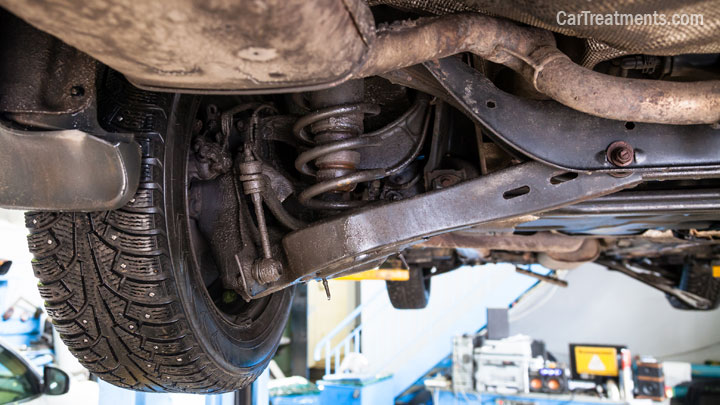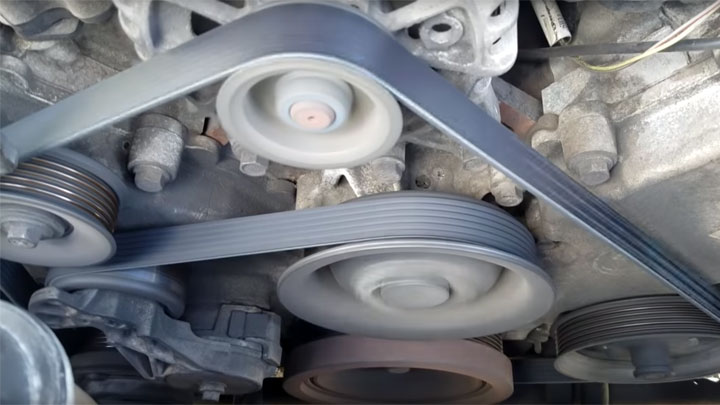9 Reasons Your Car Makes a Rattling Noise When Accelerating
Is your vehicle making a rattling sound when under acceleration? If so, you’re certainly not alone. Complaints of rattling noises from various points of origin are among the most common of automotive issues.
More often than not, locating the source of such a rattle, is more tedious than conducting the actual repair to follow. Here are the most common causes of that rattling noise when accelerating.

See Also: 9 Reasons Your Car Shakes When Accelerating
Where’s the Rattling Noise Coming From?
Rattling noises can be emitted from nearly any area of your vehicle, with many such noises varying significantly in tone and intensity. The key to remedying a noise of this nature is to accurately determine its origin, thereby making further inspection possible.
The source of vehicle rattles can be easily divided into several different categories. These categories include underbody rattles, wheel well rattles, under the hood rattles, and interior rattles. By categorizing your vehicle’s noise as described, you are better able to focus your diagnostic efforts.
Under Vehicle Rattle

Rattling noises from underneath a vehicle are extremely common. The bulk of these noises can be traced back to exhaust related issues. Noises of this nature tend to be most noticeable when a vehicle’s engine is placed under a load, or when accelerating.
#1 – Loose Exhaust Hangers and Clamps
With time, an exhaust system’s hangers and clamps tend to deteriorate, largely at the hands of corrosion. When this occurs, these vital components can loosen, or decay to the point of failure.
As a result, excessive vibration can occur. This produces noise that often varies in intensity under acceleration.
Remedying issues of this nature typically involves component replacement. Damaged hangers should be replaced with OEM equivalent parts when needed, as should rusted or otherwise compromised exhaust clamps.
#2 – Failed Catalytic Converter
Today’s vehicles employ the use of catalytic converters to break down common emissions-related pollutants, turning them into less toxic chemicals.
Unfortunately, these devices can fail at the hands of overheating or impact, causing pieces of their internal structure to break away, and be left to rattle about. This noise often sounds like marbles being shaken inside of a can.
When a catalytic converter fails, replacement becomes necessary. However, catalytic converters usually operated without issue, unless damaged by an underlying factor. The root cause of this damage should be diagnosed before unit replacement.
#3 – Damaged Heat Shield
A vehicle’s exhaust system is typically clad in numerous heat shields that protect other components from the effects of heat radiation. While heat shields tend to be relatively trouble-free, they are prone to the effects of rust and corrosion.
In cases such as these, a heat shield can break free from its welds, and be left to vibrate against nearby exhaust components.
When a heat shield begins to separate from its mounts, it can either be tack welded into place, or replaced and reattached. Replacement is typically necessary if rust has completely compromised a heat shield’s integrity.
Wheel Well Rattle

In a number of cases, rattling noises can project from a vehicle’s front end or wheel wells. More often than not, worn or damaged brake, steering, or suspension components are to blame.
In most cases, a thorough visual inspection will be necessary to isolate the root cause of such noises.
Related: 9 Causes of Steering Wheel Noise When Turning
#4 – Poor Fitting Brake Components
A vehicle’s brake components are placed under a tremendous amount of force when bringing a car or truck to a stop. Because of this, individual components tend to shift if not fitted in a relatively snug manner.
If one or more brake pads are missing their anti-rattle clips, brake chatter often results.
Whenever you suspect that your brakes are producing an unusual noise of any type, an immediate inspection is necessary. If you do not feel comfortable diagnosing such an issue yourself, seek professional advice.
#5 – Loose or Damaged Steering/Suspension Components
A vehicle relies upon its steering and suspension components to provide superb handling and a sufficient degree of ride comfort. However, these components can, and do age with time, leading to a host of wear-related issues.
Bushings can become worn, shocks and struts can lose their efficiency, and linkages can display free play within their end sockets. Additionally, any type of prior impact damage can also cause similar issues.
To diagnose the failure of individual steering and suspension components, a thorough inspection must be conducted. In many cases, pressure must be applied to each component in order to accurately check for free-play.
Under Hood Rattle

At times, rattling noises can originate from a vehicle’s engine compartment, leading to significant concern. The root cause of these noises can vary significantly, and differ in severity. It may even be your hood latch to blame.
Any irregular engine noise should be investigated immediately, to prevent further issues.
#6 – Engine Accessory Issues
While many fear the worst when an odd noise is emitted from their vehicle’s engine, the actual offending issue is often far less dire than one might imagine. In many cases, such noises are related to engine accessory components, instead of actual internal engine issues.
The bearings of any drive belt driven component are prone to failure, which produces a range of noises, including rattling. Lose hold-down brackets are also a common source of engine rattles.
When a rattling noise is believed to be coming from your vehicle’s engine bay, it is important to isolate the location of the offending component.
While doing so can often be tricky, several steps can be taken to simplify your search. Begin by checking to ensure that all engine mounted hold-down brackets are tight.
If you are led to believe that a belt-driven accessory is to blame, you can actually remove your belt, start your vehicle, and lightly rev your engine. This will allow you to see if this noise persists.
However, this test should only be conducted for a few seconds, as a vehicle’s drive belt facilitates the function of vital engine equipment, such as the water pump and alternator.
#7 – Internal Engine Issues
While rare in relation to alternative sources of noise, internal engine issues can indeed produce a rattling sound.
The three main culprits of the internal engine-related rattle are piston slap, rod knock, and lifter related issues, which all produce a distinct noise.
- Piston slap tends to sound like a muffled, metallic rattling noise that changes in frequency with engine speed.
- Rod knock produces an unmistakable metal-on-metal clatter, that slows in frequency at low speeds.
- Lifter related noises are most commonly described as a “ticking” which also mirrors the speed of an engine.
Each of the aforementioned issues are typically expensive to remedy, and often require extensive internal engine work or an engine overhaul.
If any such sound is heard and is believed to be coming from your vehicle’s engine bay, pull over at the first available opportunity, and shut off your ignition.
Interior Rattling Sounds

One of the most common, yet least concerning of all rattles, are those that originate inside of your vehicle’s cabin. While these noises are certainly aggravating, they are seldom serious in nature.
Interior rattles can often be remedied in minutes, with little necessary effort, by simply tracking down the source of such noises by ear.
#8 – Loose Trim or Compartments
In many cases, an interior rattle is caused by little more than a loose piece of interior trim, or an ill-fitting glove compartment door. As a motorist accelerates their vehicle, these loosened components begin to vibrate ever more quickly, producing an audible noise.
Locating the root cause of an interior rattle is generally no more difficult than placing hand pressure on various components within the vehicle’s cabin. While doing so, listen for the offending rattle to be stifled.
Kick panel trim, doors (latch assembly, lock cylinder, window regulator, etc.), dash bezels, glove compartment doors, and center console lids are all common sources of rattles.
See Also: 4 Causes of a Window That Won’t Go Up
#9 – Loose Change or Other Small Items
Another common cause of interior rattles is the vibration of spare change and other small items within a vehicle’s cup holder or ashtray. Such items are often forgotten within a vehicle’s interior, only to be remembered when traveling down the road.
These noises can be alleviated by simply removing the offending change, or any other loose items that are rattling about.
The future occurrence of such noises can also be prevented by emptying all cup holders, ashtrays, and change receptacles on a weekly basis.
- Car Temperature Gauge Stopped Working? (Here’s Why) - Apr 15, 2024
- Ignition Coil vs Coil Pack (What’s the Difference?) - Apr 8, 2024
- Windshield Wipers Won’t Turn Off? (Causes and What to Do) - Apr 5, 2024
